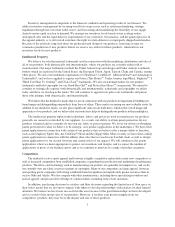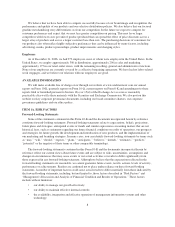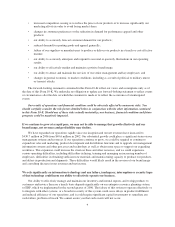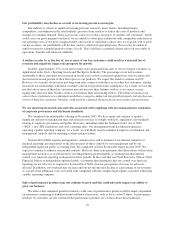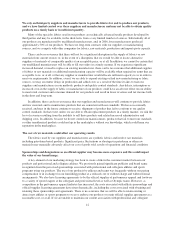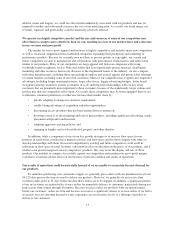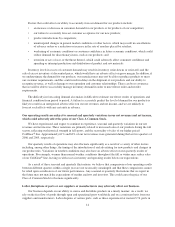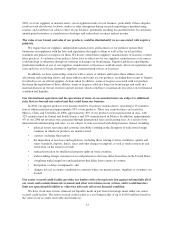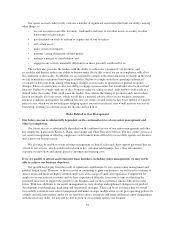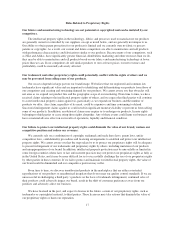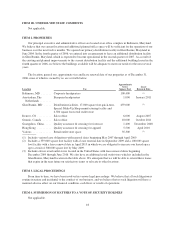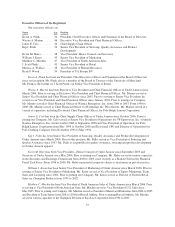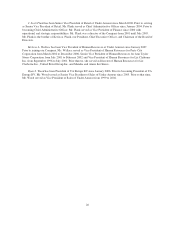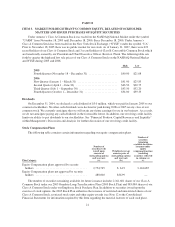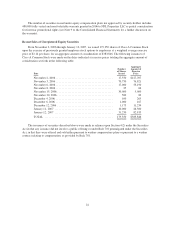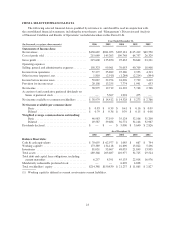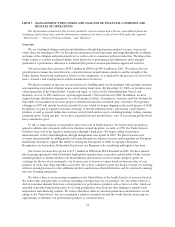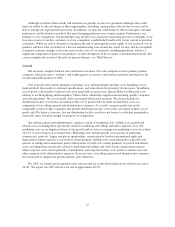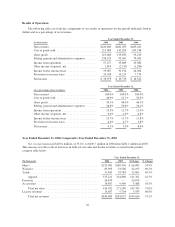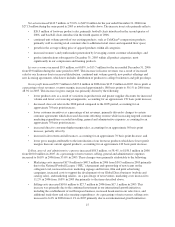Under Armour 2006 Annual Report Download - page 25
Download and view the complete annual report
Please find page 25 of the 2006 Under Armour annual report below. You can navigate through the pages in the report by either clicking on the pages listed below, or by using the keyword search tool below to find specific information within the annual report.Risks Related to Proprietary Rights
Our fabrics and manufacturing technology are not patented or copyrighted and can be imitated by our
competitors.
The intellectual property rights in the technology, fabrics and processes used to manufacture our products
are generally owned or controlled by our suppliers, except as noted below, and are generally not unique to us.
Our ability to obtain patent protection for our products is limited and we currently own no fabric or process
patents or copyrights. As a result, our current and future competitors are able to manufacture and sell products
with performance characteristics and fabrications similar to our products. Because many of our competitors, such
as Nike and Adidas, have significantly greater financial, distribution, marketing and other resources than we do,
they may be able to manufacture and sell products based on our fabrics and manufacturing technology at lower
prices than we can. If our competitors do sell similar products to ours at lower prices, our net revenues and
profitability could be materially adversely affected.
Our trademark and other proprietary rights could potentially conflict with the rights of others and we
may be prevented from selling some of our products.
Our success depends in large part on our brand image. We believe that our registered and common law
trademarks have significant value and are important to identifying and differentiating our products from those of
our competitors and creating and sustaining demand for our products. We cannot assure you that obstacles will
not arise as we expand our product line and the geographic scope of our marketing. From time to time, we have
received claims relating to the intellectual property rights of others, and we expect that third parties will continue
to assert intellectual property claims against us, particularly as we expand our business and the number of
products we offer. Any claim, regardless of its merit, could be expensive and time consuming to defend.
Successful infringement claims against us could result in significant monetary liability or prevent us from selling
some of our products. In addition, resolution of claims may require us to redesign our products, license rights
belonging to third parties or cease using those rights altogether. Any of these events could harm our business and
have a material adverse effect on our results of operations, liquidity and financial condition.
Our failure to protect our intellectual property rights could diminish the value of our brand, weaken our
competitive position and reduce our revenues.
We currently rely on a combination of copyright, trademark and trade dress laws, patent laws, unfair
competition laws, confidentiality procedures and licensing arrangements to establish and protect our intellectual
property rights. We cannot assure you that the steps taken by us to protect our proprietary rights will be adequate
to prevent infringement of our trademarks and proprietary rights by others, including imitation of our products
and misappropriation of our brand. In addition, intellectual property protection may be unavailable or limited in
some foreign countries where laws or law enforcement practices may not protect our proprietary rights as fully as
in the United States, and it may be more difficult for us to successfully challenge the use of our proprietary rights
by other parties in these countries. If we fail to protect and maintain our intellectual property rights, the value of
our brand could be diminished and our competitive position may suffer.
From time to time, we discover unauthorized products in the marketplace that are either counterfeit
reproductions of our products or unauthorized irregulars that do not meet our quality control standards. If we are
unsuccessful in challenging a third party’s products on the basis of trademark infringement, continued sales of
their products could adversely impact our brand, result in the shift of consumer preferences away from our
products and adversely affect our business.
We have licensed in the past, and expect to license in the future, certain of our proprietary rights, such as
trademarks or copyrighted material, to third parties. These licensees may take actions that diminish the value of
our proprietary rights or harm our reputation.
17


